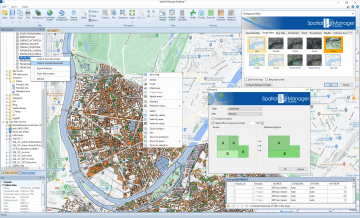Difference between revisions of "Spatial Manager Desktop™"
(→Links) |
|||
| Line 63: | Line 63: | ||
*[[Spatial Manager Desktop™ 2014 Basic Tutorial | Basic Tutorial]] | *[[Spatial Manager Desktop™ 2014 Basic Tutorial | Basic Tutorial]] | ||
| + | *[[Spatial Manager Desktop™ 2014 Technical solutions | Technical solutions]] | ||
*[[Spatial Manager Desktop™ 2014 Changelog | Changelog]] | *[[Spatial Manager Desktop™ 2014 Changelog | Changelog]] | ||
*[[Spatial Manager Desktop™ 2014 FAQs | FAQs]] | *[[Spatial Manager Desktop™ 2014 FAQs | FAQs]] | ||
*[[Spatial Manager Desktop™ 2014 EULA | End User License Agreement]] | *[[Spatial Manager Desktop™ 2014 EULA | End User License Agreement]] | ||
Revision as of 17:36, 7 November 2013
Spatial Manager Desktop™ is a desktop application designed to manage in a simple, fast and inexpensive way spatial data. Developed by a group of professionals working in the areas of GIS, Planning, Infrastructure and Civil Engineering, it includes powerful tools to address the management and operation work more common in the world of spatial information, among which may be highlighted the following:
- Fast display of graphic and alphanumeric spatial information coming from the most frequently used formats and data source types
- Easily open spatial data files (SHP, GPX, SDF, KML, OSM, ASCII points, ...)
- Drag and drop spatial data to the maps
- Gain access to spatial database servers (SQL Server, PostGIS, WFS, ...), and ODBC connections
- Easy development of maps and easy to use styling methods
- Advanced systems for information access, such as shortcuts and user data sources that can store connection parameters or source configuration
- Systems for selecting and filtering spatial information
- Alphanumeric and spatial queries
- Edit alphanumeric data and partially edit spatial features
- Find and replace data
- Management of the layers in the map and the storage of such layers
- Make new layers from selection or queries
- Split layers in new layers for thematic or data discrimination analysis
- Smart systems for map opening when modifying data sources
- Tools for the import and export between different formats or storage systems of spatial data
- Geometries transformation based on different coordinate systems in the import and export processes
- Easy methods to export the information to be used in office applications or CAD
- Fast and intuitive printing of maps or selected features
- Definition and management of tasks for import or export processes
- Running tasks direct from the application or from the command line and chained tasks (batch processing)
To get an overview of the application, please watch this video:
Providers
Spatial Manager Desktop™ accesses spatial data for reading and/or writing using its own data providers. The application access to different data formats and storage systems depending on the spatial data providers installed, which can be included as standard in the application itself or developed by the users themselves or others. At this time, the list of available providers is the following:
- ESRI Shape file - (SHP)
- Google Earth file - (KML, KMZ)
- OpenStreetMap XML file - (OSM) (1)
- GPS exchange format file - (GPX) (1)
- ASCII text file - (ASC, CSV, NEZ, TXT, XYZ, UPT)
- SQLite file - (SQLITE, DB)
- PostGIS database
- Microsoft SQL Server Spatial database
- Open Database Connectivity ODBC (1)
- Autodesk SDF file - (SDF) (3)
- WFS data store (1) (3)
- MySQL database (1) (3)
- MicroStation v.7 file - (DGN) (2)
- AutoCAD DXF file - (DXF) (2)
- ESRI ArcInfo export file (ASCII) - (E00) (1) (2)
- MapInfo file - (TAB) (2)
- MapInfo interchange format file - (MIF/MID) (2)
- GeoJSON file - (GEO.JSON) (1) (2)
- WFS data store (1) (2)
(1) Read-only
(2) OGR data source
(3) FDO provider
Links
On this page you will find all the technical information available on the implementation as well as tutorials, additional data, ...
